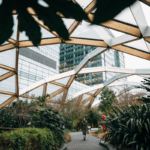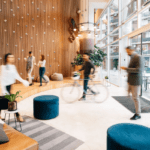The last few decades have seen huge advances in technology and shifting business models. As light bulbs last longer and sensors become more affordable, lighting companies have shifted their offerings towards a model focused on delivering “lighting as an experience,” as opposed to exclusively selling hardware. These changes are driving exciting advances in smart lighting and intelligent workplaces.
We asked our team of building engineers and cross-system experts for a crash course on smart lighting. Here’s 5 questions and answers that we hope you find illuminating (pun intended).
1. Why is smart lighting so important in the commercial building space?
Lighting is one of the most significant areas of technology in the commercial building space for several reasons. First, lighting is the second largest consumer of energy in commercial buildings, after heating and cooling. The U.S. Energy Information Administration estimates that lighting accounted for 143 billion kWh in 2017, equal to about 11% of total commercial sector electricity consumption. Secondly, lighting is the most pervasive technology in the built environment. The fact that some form of lighting is everywhere in a building means that it can be a powerful way of measuring other aspects of the occupant experience, like air quality, occupancy, and temperature. Finally, lighting also has a measurable impact on physical well-being, with an especially noticeable impact on circadian rhythms.
2. What’s circadian rhythm and what does it have to do with buildings?
Circadian rhythms are physical, mental, and behavioral changes that follow a roughly 24-hour cycle. Nearly all living things—animals, plants, even tiny microbes—experience circadian rhythms that influence important bodily functions, like sleep-wake cycles, hormone release, and body temperature. Circadian rhythms are produced by natural factors within the body, like hormones and genetic predisposition, but they are also strongly affected by external signals from the environment, especially light. In fact, creating lighting conditions that support patients’ natural circadian rhythms has been linked with faster healing in hospitals. Alternatively, abnormal circadian rhythms have been associated with insomnia, obesity, diabetes, depression, bipolar disorder, and seasonal affective disorder.
In an office environment, numerous studies have shown a direct relationship between the amount of natural light office workers get and their performance at work. Generally, people near windows are more engaged, while people further from the windows have poorer sleep and are more likely to be sleepy during the day. We can’t get daylight to everyone all the time, so how do we integrate lighting into design to improve the indoor experience? How can we go beyond a simple on-off switch and use daylight harvesting, spectrum control, and scheduling to match our natural circadian rhythm? How can we create an indoor experience that promotes well-being and inspiration? Fortunately, new technical advances like human-centric lighting are setting out to address these challenges.
3. Does that mean higher energy consumption is required for better lighting in buildings?
Not really. Just like how over air conditioning is a major problem in buildings, over illumination is also rampant. Several studies have shown that workplaces could reduce illumination by as much as 20% before occupants reported any noticeable discomfort. Meanwhile, we know that prolonged exposure to lights that are too bright can cause eye strain, headaches, fatigue, stress, anxiety, and even cardiovascular disease. The key is offering greater personalization. For example, the Light Right Consortium and National Research Council of Canada found that personal dimming options delivered 15% energy savings. At Comfy HQ, we know first-hand that greater individual control of temperature and lighting delivers operational savings and an improved workplace experience.
4. What is connected lighting?
First, a very brief history on the evolution of lighting. Lighting in buildings started off as a basic necessity and came in the form of bulbs that turned on and off with a switch on the wall. Over the last 20 years, we’ve seen the emergence of more energy-efficient light bulbs and programmable controls that link to a larger on-site lighting control system and allow for more fine-tuning and schedule setting.
Today, we are at the infancy of a new era, often called “connected lighting.” Advances in IoT are making it possible for individual lighting fixtures in a building to become IP addressable. Why is this significant? Because lighting fixtures are so pervasive in a building, when they become IP addressable and outfitted with sensors, we suddenly create a complex wireless network of thousands of sensors throughout the entire building. With connected lighting, the people tasked with planning, delivering, and managing workspaces, services, and amenities can easily access a host of information (on elements like temperature, lighting, and occupancy)that used to be incredibly time-consuming or in some cases physically impossible to collect. The ability to measure and access this information unlocks great potential in improving operational efficiency, space utilization, energy efficiency and occupant experience.
5. What are some of the advances and trends we can look forward to?
At this point, widespread adoption of LEDs is a given. It’s already happening, because it simply makes sense. Next on the horizon, we are looking forward to widespread advancements in the quality of lighting in buildings, especially greater occupant control of light intensity and color, which can in turn lead to significant improvements in wellness and productivity while simultaneously reducing energy use. We are also incredibly excited by the opportunities that emerge with connected lighting. When connected lighting links to the cloud and connects to sensors, smart devices, and apps, corporate real estate executives are able to turn real-time data into actionable insights and occupants are able to better control, communicate, and connect with their workplaces.
If you’d like to learn more about how we’re leveraging advances in smart lighting to create a better workplace experience, check out Comfy’s latest features.



